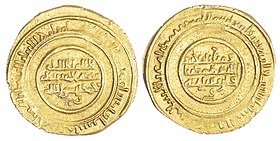| This article needs additional citations for verification. Please help improve this article by adding citations to reliable sources. Unsourced material may be challenged and removed. Find sources: "Al-Mu'izz ibn Badis" – news · newspapers · books · scholar · JSTOR (December 2009) (Learn how and when to remove this message) |

Al-Muʿizz ibn Bādīs (Arabic: المعز بن باديس; 1008–1062) was the fourth ruler of the Zirids in Ifriqiya, reigning from 1016 to 1062. His regent was his paternel aunt Saïda bint Mansur until he reached majority.
Name
Ibn Khallikan wrote that the name "al-Mu'izz" was ordinarily an epithet (laqab), but in the case of al-Mu'izz ibn Badis it seems to have been his given name (ism). Ibn Khallikan wrote that he had searched in various books and consulted with scholars from North Africa in an attempt to determine whether al-Mu'izz had a different given name, but he never found any; in the absence of any suggestion to the contrary, he concluded that "al-Mu'izz" must have been his given name.
Political career
According to Ibn Khallikan, al-Mu'izz ibn Badis was born at al-Mansuriya on 19 January 1008 (7 Jumada al-Awwal, 398 AH).
Al-Muizz ascended the throne as a minor following the death of his father Badis ibn Mansur, with his aunt, Umm Mallal, acting as regent. According to Ibn Khallikan, al-Mu'izz's inauguration was held at al-Muhammadiya on 13 May 1016 (3 Dhu al-Hijja, 406 AH). In 1016 there was a bloody revolt in Ifriqiya in which the Fatimid residence Al-Mansuriya was completely destroyed and 20,000 Shiites were massacred. The unrest forced a ceasefire in the conflict with the Hammadids of Algeria, and their independence was finally recognized in 1018.
Al-Muizz took over the government in 1022 following the overthrow of his aunt. The relationship with the Fatimids was strained, when in 1027 they supported a revolt of the Zanatas in Tripolitania which resulted in permanent loss of control of the region. His son Abdallah shortly ruled Sicily in 1038-1040, after intervening with a Zirid army in the civil war that broke out in the island.
The political turmoil notwithstanding, the general economic wellbeing initially made possible an extensive building programme. However, the kingdom found itself in economic crisis in the 1040s, reflected in currency devaluation, epidemic and famine. This may have been related to the high level of tribute which the Zirids were compelled to pay annually to the Fatimids (one million gold dinars a year).
When al-Muizz (under the influence of Sunni jurists in Kairouan, growing Sunni public pressure in his realm and a violent backlash against the Shi'ite minority) recognised the Abbasids in Baghdad as rightful Caliphs in 1045 and adopted Sunni orthodoxy, the break with the Fatimids was complete. He even denounced the Fatimids and their followers as heretics in newly minted coinage.
The Fatimids then sent a military campaign composed of Bedouin tribes of the Banu Hilal and the Banu Sulaym from Egypt to Ifriqiya. The invasion of the Bedouin (1051–1052) led to great hardship after the defeat at Jabal Haydaran, severely impacting agriculture in Ifriqiya. The Fatimids dispatched Makin al-Dawla to rally the Bedouin invaders and duly besiege al-Muizz in Kairouan and conquer Gabes and much of Ifriqiya’s hinterlands in 1053–1054. The conquest of Kairouan in 1057 resulted in further anarchy. The Zirids lost control over the hinterland and were only able to retain the coastal areas, the capital being moved to Mahdia. With the growth of Bedouin Emirates and the continuing insecurity inland, the economy of Ifriqiya looked increasingly towards the Mediterranean, with the result the coastal cities grew in importance through maritime trade and piracy.
According to Ibn Khallikan, al-Mu'izz died on 13 August 1062 (4 Sha'ban, 454 AH) of some sort of liver disease. He was succeeded by his son Tamim ibn Muizz.
Literary career
He is usually thought to be the author of the famous Kitab `umdat al-kuttab wa `uddat dhawi al-albab (Staff of the Scribes). It is divided into twelve chapters, writing, amongst other things, on the excellence of the pen, on the preparation of types of inks, such as colored and metallic inks (including ones prepared from silver filings and alcohol), the coloring of dyes and mixtures, secret writing, the making of paper and Arabic gum and glue.
Ibn Sharaf and Ibn Rashīq were rival poets at his court. He is said to have stoked their rivalry.
References
- Miled, Emna Ben (1998). Les tunisiennes ont-elles une histoire? (in French). E. Ben Milen. p. 188. ISBN 978-9973-807-04-5. Retrieved 2024-07-31.
- ^ Ibn Khallikan. Guillaume Baron Mac-Guckin de Slane (ed.). Deaths of Eminent Men and the Sons of the Epoch (Vol. III). pp. 386–8. Retrieved 12 April 2022.
- Ivan Hrbek (1 Jan 1992). Africa from the Seventh to the Eleventh Century (abridged, illustrated ed.). James Currey Publishers. pp. 172–3. ISBN 9780852550939.
- Linda G. Jones (6 Aug 2012). The Power of Oratory in the Medieval Muslim World. Cambridge University Press. p. 136. ISBN 9781107023055.
- Trudy Ring; Noelle Watson; Paul Schellinger (5 Mar 2014). Middle East and Africa: International Dictionary of Historic Places. Routledge. p. 37. ISBN 9781134259939.
- Luscombe, David; Riley-Smith, Jonathan, eds. (2004). The New Cambridge Medieval History, Volume 2; Volume 4. Cambridge University Press. p. 696. ISBN 9780521414111.
- Brett, Michael (2017). Fatimid Empire. Edinburgh University Press. pp. 186–187. ISBN 978-0-7486-4077-5.
- Levey, Martin (1962). "Mediaeval Arabic Bookmaking and Its Relation to Early Chemistry and Pharmacology". Transactions of the American Philosophical Society. New Series. 52 (4): 1–79. doi:10.2307/1005932. ISSN 0065-9746. JSTOR 1005932.
- "MuslimHeritage.com - Topics". www.muslimheritage.com. Archived from the original on 2002-12-17.
- "Technology Transfer in the Chemical Industries". Archived from the original on 2008-03-09. Retrieved 2008-03-29.
- Pellat, Charles (1971). "Ibn Sharaf al-Ḳayrawānī". In Lewis, B.; Ménage, V. L.; Pellat, Ch. & Schacht, J. (eds.). The Encyclopaedia of Islam, Second Edition. Volume III: H–Iram. Leiden: E. J. Brill. pp. 936–937. OCLC 495469525.
| Preceded byBadis ibn al-Mansur | Zirid emir of Ifriqiya 1016–1062 |
Succeeded byTamim ibn al-Mu'izz |